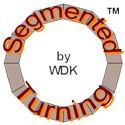 |
Segmented TurningDesign your first segmented project in 5 minutes with the Segmented Project Planner |
|||
|
| Products | Classes | Free Plans | Hints | Buy Now | Gallery | Wood Costs | User Projects | FAQ |
| Product Pages | Segmented Project Planner | Book | DVD | Project Library |
|
3. Designing a Project - This section, the real meat of the book, starts with the principles of design, their applicability to segmented projects, and how the elements of design are used to achieve design goals. Manual, semi-computerized and fully computerized methods of getting the basic object drawn are presented. Then several ways of adorning a segmented project are shown (bottom designs, grain orientation, segment alignment, spacers and gaps, segment colors, mosaics, inlays, laminates, sandwiches, cookie logs, and the power of joints). This list could go on and on, but I had to stop somewhere. 4. Selecting Your Materials - The process I use for choosing the right pieces of wood to use is spelled out. The effects of choosing consistent or irregular coloring and grain orientations are presented. 5. Preparing Your Materials - The ripping, re-sawing, surfacing and/or dimensional sanding steps needed to get materials ready for the project are explained. The special needs of sandwiched construction are also discussed. 6. Cutting Rings - I spell out how to cut segments using a table saw, band saw, or chop saw. 7. Gluing Rings - I talk about three methods of gluing and clamping a segmented ring along with how to eliminate gaps in the glue joints. 8. Flattening Rings - I present seven ways of getting segmented rings flat so they can be stacked up into the project form. 9. Mounting Your Piece for Turning - Several different ways of putting a project on the lathe along with the applicability of each method are discussed. 10. Stacking up the Project - The two ways of stacking up and gluing a segmented project are described. My way (stack a little, turn a little) and the other way (one big glue-up). 11. Sanding Your Project - Getting the most out of sandpaper and sanding the inside and outside of the project are discussed. 12. Finishing - This section spells out how to get the most out of lacquer, varnish, shellac, oil, and friction finishes. 13. Photographing the Result - I present three simple setups you can use to take professional looking pictures of completed projects. 14. Documenting Your Masterpiece - This section discusses why you should document your projects, the forms documentation may take, what to include in a document, and shows a sample document. 15. Project Photo Essay - This is a step-by-step description of the design and construction processes for one of my recent segmented projects. It is intended to bring together all the material presented in the previous sections. 16. Project Plans - This section presents a picture and the cut list for each of 8 segmented projects. 17. AcuMiter™ Sled Plans - In this section, I describe how to build and set up a miter sled that provides for accurate and repeatable segment cuts. | |
